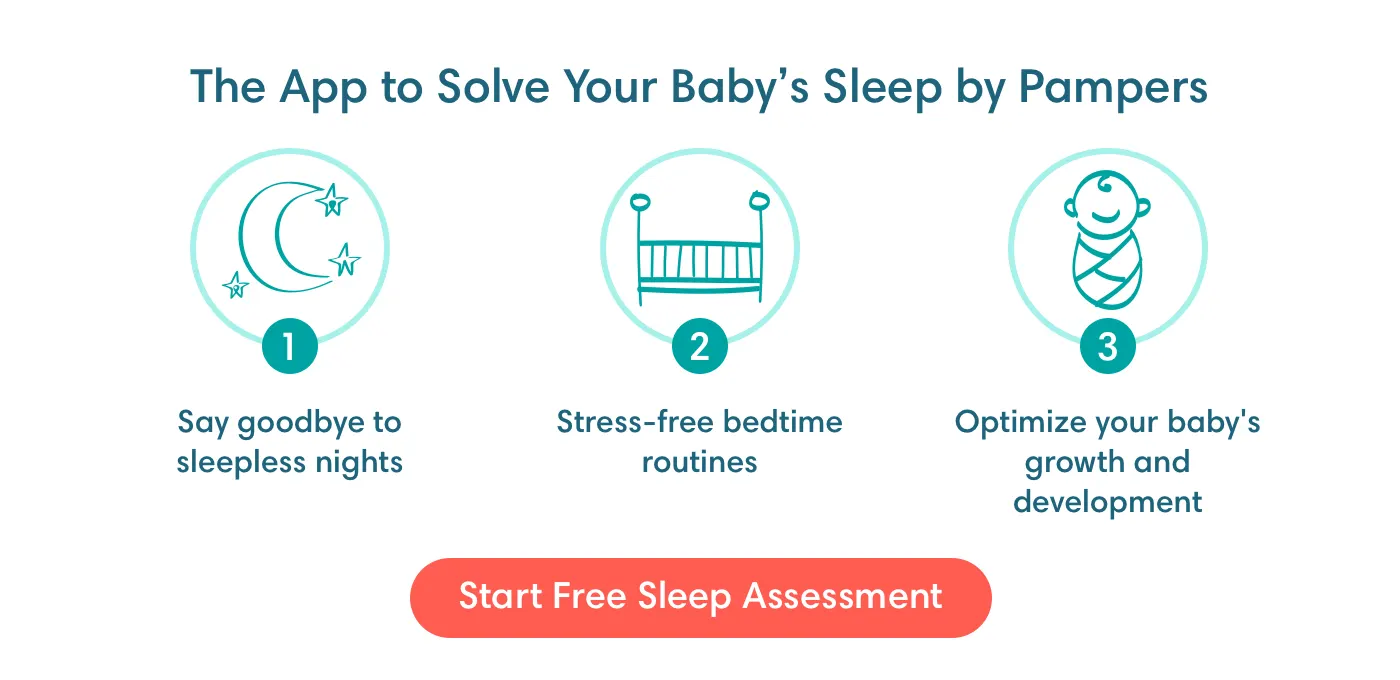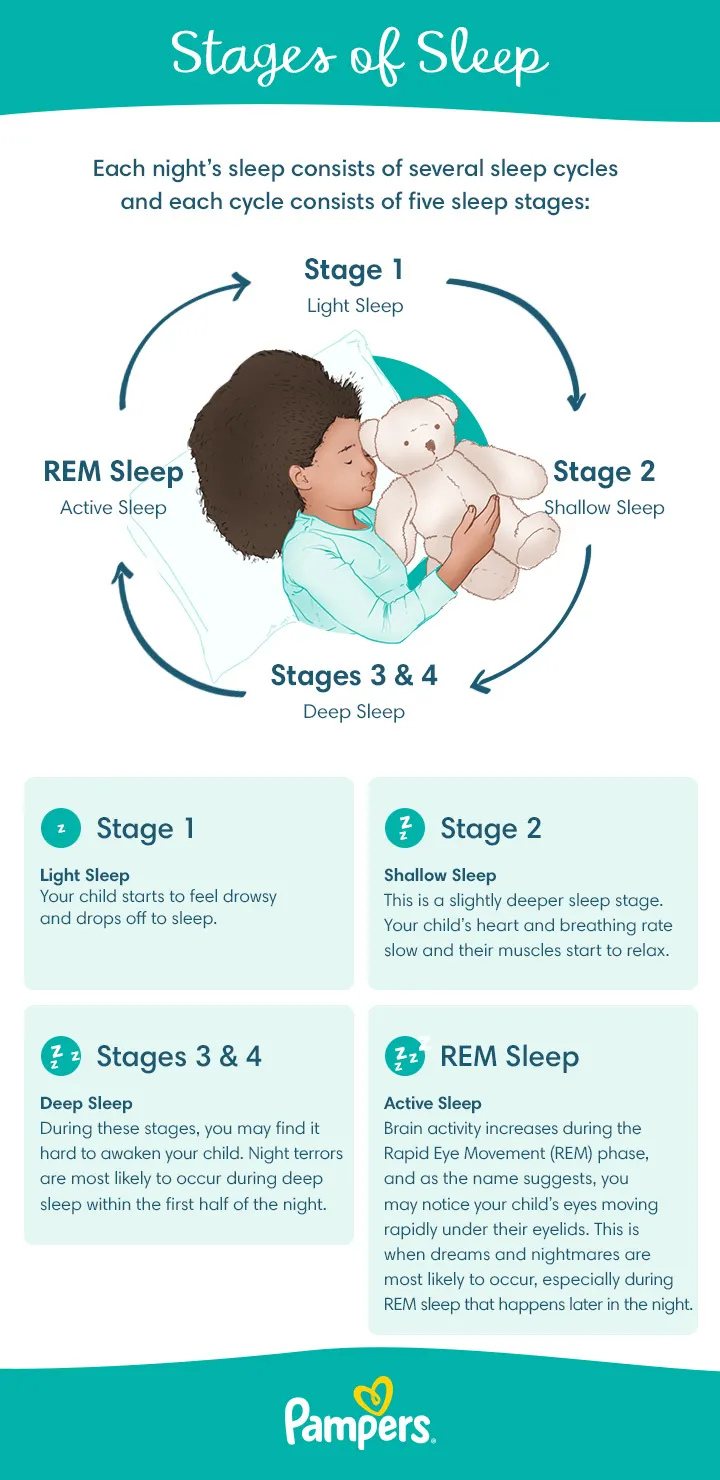How to Help Your Kids Through Night Terrors
If your 4- or 5-year-old thrashes around in the middle of the night with their eyes open, looking terrified, and won’t respond to you, they may be having a night terror. Kids’ night terrors are different from nightmares and are usually not a cause for concern. Still, they can be frightening to observe for many parents. Read on to learn what night terrors are, what causes them, and how to help if your kid has one.
What Are Night Terrors in Kids?
A night terror, or “sleep terror,” is a type of sleep behavior that may resemble a nightmare. It’s considered a parasomnia—an undesired occurrence during sleep—and is more closely related to sleep walking and other sleep disruptions. Night terrors are rare, affecting only about 3 to 6 percent of kids between the ages of 4 to 12. Witnessing a night terror can be upsetting for parents, but it’s not as harmful as it might look. Unlike a nightmare, once the night terror is over, kids will go back to sleep quickly, and won’t remember it. An episode may last about 5 to 15 minutes. A night terror is usually not a cause for concern or a sign of a deeper medical issue.
In Summary Kids rarely experience night terrors, but when they do, know that it’s a simple sleep disturbance and children don’t remember it. Episodes can last from 5 to 15 minutes, and although they may look scary to you, they won’t hurt your little one. |
At What Age Do Night Terrors Occur?
Some parents wonder if babies or toddlers can have night terrors, but they almost always happen in older kids, usually those aged between 4 and 12. Although there have been rare cases of night terrors reported in toddlers as young as 18 months, it’s very unlikely for a toddler to experience a night terror. Most likely, your 15-month-old baby won’t experience night terrors, nor will your 2-year-old toddler. If anything, they may experience a nightmare (more on that below). Some children experience only one night terror, while others experience several before these episodes stop as the nervous system matures. Keep in mind that it’s uncommon for kids to have frequent night terrors over a prolonged period of time, so if you do notice them happening often, you may want to consult your child’s healthcare provider for advice.
Signs of a Night Terror
If your child is having a night terror, there are some signs and symptoms you can look out for. Your child may:
sit upright in bed
suddenly scream or shout out in distress
breathe faster
have a quicker heartbeat
sweat
thrash around
act upset and scared
open their eyes but be hard to awaken
calm down after a few minutes or so and then go straight back to sleep
have no memory of the episode once awake.
If you’re sleeping in separate rooms or happen to be a deep sleeper, you may not even notice that your child is having a sleep terror, unless you are awoken by the sounds of screaming or thrashing.
In Summary Night terrors affect kids between the ages of 4 and 12 years old. Although they’ve been reported in toddlers as young as 18 months, it’s very rare for babies or young toddlers to experience night terrors. If your child does have one, you may notice certain signs of distress, such as open eyes but not being awake, screaming or crying, thrashing around, heavy breathing, acting scared, etc. |
What Causes Night Terrors in Children?
Night terrors can arise when a child’s central nervous system is over-aroused during sleep. Night terrors typically occur during non-dreaming sleep; they often take place within two hours of going to sleep and may last about 5 to 15 minutes. According to child health experts, these are some factors that could increase the likelihood of a night terror occurring:
Being overtired or not getting enough sleep
Feeling ill or stressed
Taking a new medication or sleeping in a new environment
A family history of night terrors or sleep walking.
Keep in mind that night terrors are not technically dreams or nightmares (which occur during Rapid Eye Movement (REM) sleep); instead, they are more like a sudden reaction of fear that happens as a child switches from one stage of sleep to another. Most of the time this transition is smooth, but some children may react by getting upset and frightened, leading to a sleep terror.
In Summary Night terrors happen when a child’s central nervous system is over-aroused during sleep. Some factors may increase the chance of experiencing night terrors, such as being overtired, ill, or stressed; taking new medications; or having a family history of sleep disturbances. |
Sleep Stages and Cycles
During sleep, children as well as adults go through several sleep cycles composed of different stages. In most of the cycles, a child is switching back and forth between non-REM sleep and REM sleep, which is when active dreaming occurs. The ratio of non-REM to REM sleep will vary over the course of the night; the first stage of REM sleep is short but will get longer as the night progresses, while non-REM sleep stages will get progressively shorter. Here's a breakdown of what happens during a night's sleep:
The Difference Between a Night Terror and a Nightmare
To understand night terrors vs. nightmares, check out the table below:
| Nightmare | Night Terror | |
|---|---|---|
| Age it may begin to occur | Can start as early as 2 years old but can occur for the first time in older children as well. | Night terrors may begin at age 4 or 5 but can also happen in kids up to about the age of 12. |
| How it looks | Your child may awaken, crying and afraid because of the frightening dream. | Your child may scream, cry, and/or thrash but not be fully awake. They may appear anxious or agitated. Your child may have their eyes open and be hard to awaken. |
| When it happens | It often occurs in the second part of the night during the REM stage of sleep, during an episode of intense dreaming. | It usually happens within two hours of falling asleep, during non-dreaming sleep. An episode may last about 5 to 15 minutes. |
| Return to sleep | Your child may have trouble falling back to sleep, as they may still be shaken by the nightmare and feel anxious. | Your child will fall back to sleep easily. |
| Memory of the experience | Your child may remember the nightmare and may want to talk about it or be comforted afterward. | Your child will have no memory of the episode. |
| Underlying issues | Nightmares are not typically associated with underlying emotional problems, but they may reflect inner fears. | Night terrors are not associated with emotional problems. |
| How to help manage an episode | Comfort and talk to your child and try to soothe and reassure them. | It’s best not to try to wake kids during a night terror. Just keep them from harming themself and let them settle back to sleep. |
| How to handle in the long-term | Talk to your healthcare provider if your child is experiencing nightly or regular nightmares. To help prevent some nightmares, avoid screen time before bed and read calming bedtime stories. | Most kids outgrow night terrors, and there are no specific steps you can take to prevent them; however, you can try to put your child to bed a little earlier to avoid any overtiredness. |
How to Help Your Child With Night Terrors
Night terrors can be upsetting for you as the parent, but the best way to handle an episode is to simply wait it out, and make sure your kids don’t hurt themselves if they’re thrashing around. If your child has a tendency to have night terrors and moves around while having them, you may want to attach a toddler bed rail to prevent any accidental falls. Avoid waking your child up from a night terror. If your child does wake up, they may be disoriented and will take longer to settle down and fall asleep again. Kids usually fall asleep on their own within minutes of the night terror ending and won’t have any memory of the night terror at all. Although there is no treatment for night terrors, here are a few things that might help prevent some of them:
Try to reduce any stress in your child's life
Create a simple and relaxing bedtime routine to help your child wind down for sleep
Make sure your little one gets enough rest
Don’t let your child get overtired, or stay up too late
Try to put your child to bed 30 minutes earlier than usual if they’re typically overtired by bedtime or if they’ve had a very tiring day
If your child is experiencing night terrors around the same time each night, try to wake them up about 15 to 30 minutes beforehand.
When to See Your Child’s Healthcare Provider
Most children will grow out of night terrors and don’t need medical attention. However, if the night terrors are frequent and you are worried about them, talk to your child’s healthcare provider, who may refer you to a sleep specialist if needed.
In Summary There aren’t any treatments for night terrors, which are different than nightmares. However, there are some things you can do to help your child sleep better and possibly prevent sleep terrors. You can reduce stress in your child’s life, create a relaxing bedtime routine, put your little one to bed early if they’re tired, and monitor night terrors as they arise. You can try waking them before a sleep terror occurs or contact your child’s healthcare provider for further advice. |
FAQS AT A GLANCE
A night terror is a form of sleep disruption called a parasomnia (an undesired occurrence during sleep). During a night terror, kids look frightened and may cry, scream, and sit up in bed. Experts say it’s best not to wake your child during a night terror. They will return to sleep soon after and won’t remember the episode.
The Bottom Line
Night terrors can be terrifying to see, and you might feel helpless and worried about what’s happening to your child. The good news is that these sleep disturbances are harmless and your little one will grow out of them. Luckily, when it comes to night terrors vs. nightmares, there’s one important difference. Unlike nightmares or bad dreams, which can leave your child feeling anxious or scared, kids don’t remember night terrors once they wake up! During an episode, don’t try to wake your child; they’ll settle down and fall back to sleep on their own soon afterward. So, although night terrors look scary, remember that they won’t hurt your little one. Creating a calming bedtime routine and ensuring your child isn’t overtired at bedtime could help prevent some episodes. If you’re worried about regular night terrors, you can always consult your child’s healthcare provider for advice, just to be on the safe side.
The information in this article is based on the expert advice found in trusted medical and government sources, such as the American Academy of Pediatrics and the American College of Obstetricians and Gynecologists. You can find a full list of sources used for this article below. The content on this page should not replace professional medical advice. Always consult medical professionals for full diagnosis and treatment.


![[CA] WSD 1 - Baby World Sleep Day 1](https://images.ctfassets.net/2ql69mthp94m/41LJkNsvtsZMN716fbD3BQ/516c6979eb937cb9587b46106452ad17/WSD_-_Desktop_-_baby_sleeping.png?fm=webp&q=70)

